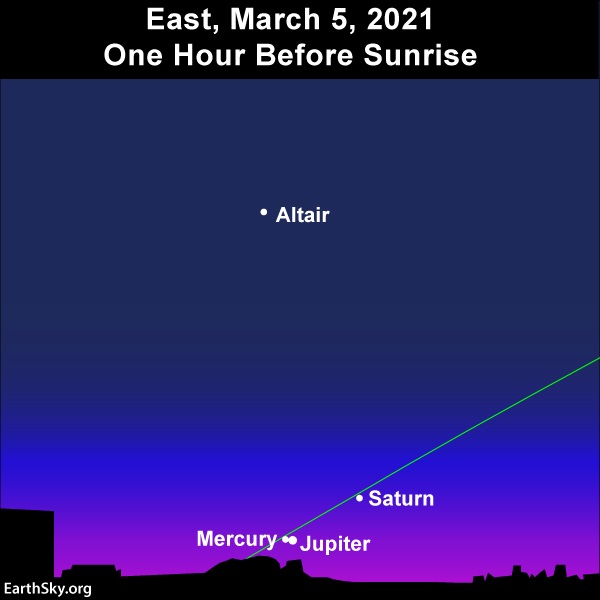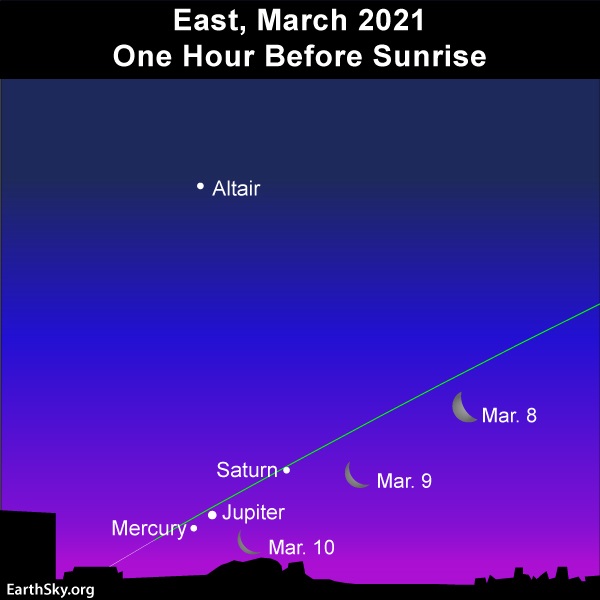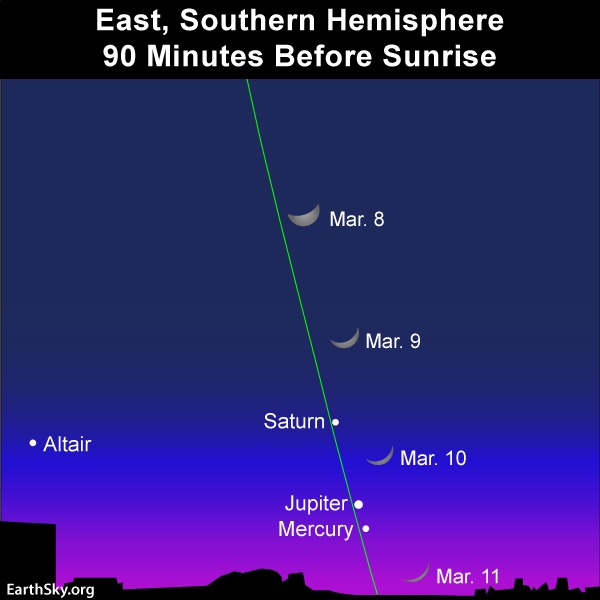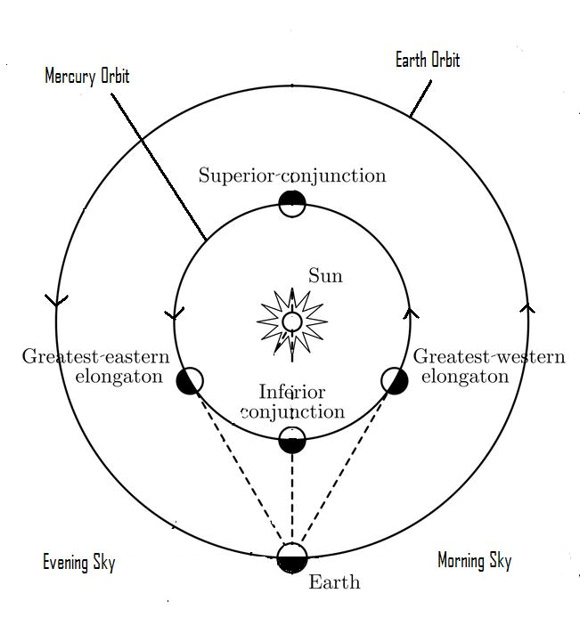
Mercury, the solar system’s innermost planet, makes a close-knit conjunction with the king planet Jupiter on March 5, 2021, and then reaches its maximum elongation from the sun for the year on March 6, 2021. But don’t wait till then to start looking for these worlds. Starting early March, from around the world, Jupiter and Mercury snuggle up plenty close together on the sky’s dome, beneath the planet Saturn! The feature chart at the top is for March 3, 2021, at North American mid-northern latitudes.

On March 5, 2021, the planets Mercury and Jupiter are in conjunction, but might be hard to view in the morning twilight. Binoculars may help.
At Mercury’s greatest elongation on March 6, the solar system’s innermost planet swings to a whopping 27.3 degrees west of the sun, placing Mercury in the morning sky before sunrise. That’s the maximum angular separation between the sun and Mercury for all of 2021!
You might think right now should feature the best time to see Mercury in 2021. Yes, that’s the case if you live in the world’s Southern Hemisphere. From the Southern Hemisphere, before sunup, you will find a glorious sight awaiting you. The line-up of three planets – Mercury, Jupiter and Saturn – soars much higher up in the Southern Hemisphere morning sky than at comparable latitudes in the Northern Hemisphere.
Even from northerly latitudes, however, you can still use the brilliant planet Jupiter to help guide you to Mercury. After all, Jupiter ranks as the 4th-brightest celestial body in all the heavens, after the sun, moon and Venus, respectively. (Venus is now lost in the sun’s glare.) At their conjunction, Jupiter and Mercury will only be 0.3 (3/10) of a degree apart. For reference, the moon’s angular diameter spans about 0.5 or 1/2 degree of sky.) If you see Jupiter but not Mercury, aim binoculars at Jupiter to view nearby Mercury joining up with Jupiter in the same binocular field.
Jupiter is about 7 times brighter than Mercury, and 12 times brighter than Saturn. Even so, Saturn might be easier to see than Mercury, because Saturn is higher up in the sky, and farther away from the twilight glare. Mercury and Saturn, though nowhere as brilliant as Jupiter, still shine as brightly as 1st-magnitude stars.
The planets align with the ecliptic (Earth’s orbital plane projected onto the sky’s dome) in the same way in both the Northern and Southern Hemispheres … except that, for the northern part of Earth, the ecliptic ,or pathway of the sun, moon and planets (the green line on our charts), makes a narrower angle with respect to the morning horizon.
Below, contrast the Northern Hemisphere chart with the Southern Hemisphere chart underneath for when the old moon sweeps by these worlds later this month..

From northerly latitudes, the narrow tilt of the ecliptic – pathway of the planets – keeps the morning planets submerged in the glow of twilight.

In March, the Southern Hemisphere has the big advantage over the Northern Hemisphere for viewing the morning planets, because the steep tilt of the ecliptic brings the planets higher up in the predawn/dawn sky.
Thus, at northerly latitudes, the planets are to the right of the sunrise point on the horizon instead of above it. They’re lower down in the predawn/dawn sky. Mercury, Jupiter and Saturn will be harder to see, as they’re buried deeper in the morning twilight. If you live as far north as Alaska where the sun and Mercury rise almost concurrently, you probably won’t see Mercury at all even with binoculars.
In short, the farther south you live, the more time before sunrise Mercury rises. We give the approximate rising times for Mercury at various latitudes here (given a clear and obstructed horizon in the direction of sunrise):
40 degrees north latitude: Mercury rises about one hour before the sun
Equator (0 degrees latitude): Mercury rises about 1 3/4 hours before the sun
40 degrees south latitude: Mercury rises about 2 1/4 hours before the sunWant more specific information? Click here for a sky almanac.
Mercury presents six greatest elongations in 2021, three in the evening sky and three in the morning sky. Because Mercury’s orbit is quite eccentric (oblong), Mercury’s greatest elongations are far from equal throughout the year, varying from about 18 to 28 degrees. We list all of Mercury’s greatest elongations for 2021 here:
Mercury greatest elongations in 2021
Jan 24, 2021: 18.6 degrees east of the sun (evening sky)
Mar 06, 2021: 27.3 degrees west of the sun (morning sky)
May 17, 2021: 22.0 degrees east of the sun (evening sky)
Jul 04, 2021: 21.6 degrees west of the sun (morning sky)
Sep 14, 2021: 26.8 degrees east of the sun (evening sky)
Oct 25, 2021: 18.4 degrees west of the sun (morning sky)
You might wonder why the difference is so extreme between the Northern and Southern Hemispheres for viewing Mercury in the morning sky. It’s because it’s now late winter in the Northern Hemisphere, yet late summer in the Southern Hemisphere. The upcoming equinox on March 20, 2021, will present the Northern Hemisphere’s vernal (spring) equinox and the Southern Hemisphere’s autumnal equinox.
Read more: Does the equinox sun rise due east and set due west?
At sunrise in late winter/early spring, the ecliptic – the roadway of the planets on the sky’s dome – hits the sunrise horizon at its shallowest angle for the year. Therefore, even at its greatest morning elongation, Mercury never gets far from the sun’s glare at this time of year, so it sits low in the glow of morning twilight.
At sunrise in late summer/early autumn, the ecliptic hits the sunrise horizon at its steepest angle for the year. Therefore, Mercury at its greatest elongation soars higher up in the sky before sunrise at southerly latitudes, showcasing the Southern Hemisphere’s best morning apparition of Mercury for the year.
If you live at mid-northern latitudes, don’t give up entirely on spotting Mercury before sunrise. Get up before dawn to view the other two morning planets: Jupiter and Saturn. Plus, the king planet Jupiter will pass 0.3 degrees south of Mercury on March 5, so you can use dazzling Jupiter as your guide “star” to Mercury!

An inferior planet – a planet that orbits the sun inside of Earth’s orbit – appears in the evening sky at its greatest eastern elongation, and in the morning sky at its greatest western elongation. The 2 inferior planets are Mercury and Venus, residing at a mean distance of 0.387 and 0.723 astronomical units from the sun, respectively.
Bottom line: Mercury, the solar system’s innermost planet, makes a close-knit conjunction with the king planet Jupiter on March 5, 2021, and then reaches its maximum elongation from the sun for the year on March 6, 2021.
from EarthSky https://ift.tt/2Pm7l09

Mercury, the solar system’s innermost planet, makes a close-knit conjunction with the king planet Jupiter on March 5, 2021, and then reaches its maximum elongation from the sun for the year on March 6, 2021. But don’t wait till then to start looking for these worlds. Starting early March, from around the world, Jupiter and Mercury snuggle up plenty close together on the sky’s dome, beneath the planet Saturn! The feature chart at the top is for March 3, 2021, at North American mid-northern latitudes.

On March 5, 2021, the planets Mercury and Jupiter are in conjunction, but might be hard to view in the morning twilight. Binoculars may help.
At Mercury’s greatest elongation on March 6, the solar system’s innermost planet swings to a whopping 27.3 degrees west of the sun, placing Mercury in the morning sky before sunrise. That’s the maximum angular separation between the sun and Mercury for all of 2021!
You might think right now should feature the best time to see Mercury in 2021. Yes, that’s the case if you live in the world’s Southern Hemisphere. From the Southern Hemisphere, before sunup, you will find a glorious sight awaiting you. The line-up of three planets – Mercury, Jupiter and Saturn – soars much higher up in the Southern Hemisphere morning sky than at comparable latitudes in the Northern Hemisphere.
Even from northerly latitudes, however, you can still use the brilliant planet Jupiter to help guide you to Mercury. After all, Jupiter ranks as the 4th-brightest celestial body in all the heavens, after the sun, moon and Venus, respectively. (Venus is now lost in the sun’s glare.) At their conjunction, Jupiter and Mercury will only be 0.3 (3/10) of a degree apart. For reference, the moon’s angular diameter spans about 0.5 or 1/2 degree of sky.) If you see Jupiter but not Mercury, aim binoculars at Jupiter to view nearby Mercury joining up with Jupiter in the same binocular field.
Jupiter is about 7 times brighter than Mercury, and 12 times brighter than Saturn. Even so, Saturn might be easier to see than Mercury, because Saturn is higher up in the sky, and farther away from the twilight glare. Mercury and Saturn, though nowhere as brilliant as Jupiter, still shine as brightly as 1st-magnitude stars.
The planets align with the ecliptic (Earth’s orbital plane projected onto the sky’s dome) in the same way in both the Northern and Southern Hemispheres … except that, for the northern part of Earth, the ecliptic ,or pathway of the sun, moon and planets (the green line on our charts), makes a narrower angle with respect to the morning horizon.
Below, contrast the Northern Hemisphere chart with the Southern Hemisphere chart underneath for when the old moon sweeps by these worlds later this month..

From northerly latitudes, the narrow tilt of the ecliptic – pathway of the planets – keeps the morning planets submerged in the glow of twilight.

In March, the Southern Hemisphere has the big advantage over the Northern Hemisphere for viewing the morning planets, because the steep tilt of the ecliptic brings the planets higher up in the predawn/dawn sky.
Thus, at northerly latitudes, the planets are to the right of the sunrise point on the horizon instead of above it. They’re lower down in the predawn/dawn sky. Mercury, Jupiter and Saturn will be harder to see, as they’re buried deeper in the morning twilight. If you live as far north as Alaska where the sun and Mercury rise almost concurrently, you probably won’t see Mercury at all even with binoculars.
In short, the farther south you live, the more time before sunrise Mercury rises. We give the approximate rising times for Mercury at various latitudes here (given a clear and obstructed horizon in the direction of sunrise):
40 degrees north latitude: Mercury rises about one hour before the sun
Equator (0 degrees latitude): Mercury rises about 1 3/4 hours before the sun
40 degrees south latitude: Mercury rises about 2 1/4 hours before the sunWant more specific information? Click here for a sky almanac.
Mercury presents six greatest elongations in 2021, three in the evening sky and three in the morning sky. Because Mercury’s orbit is quite eccentric (oblong), Mercury’s greatest elongations are far from equal throughout the year, varying from about 18 to 28 degrees. We list all of Mercury’s greatest elongations for 2021 here:
Mercury greatest elongations in 2021
Jan 24, 2021: 18.6 degrees east of the sun (evening sky)
Mar 06, 2021: 27.3 degrees west of the sun (morning sky)
May 17, 2021: 22.0 degrees east of the sun (evening sky)
Jul 04, 2021: 21.6 degrees west of the sun (morning sky)
Sep 14, 2021: 26.8 degrees east of the sun (evening sky)
Oct 25, 2021: 18.4 degrees west of the sun (morning sky)
You might wonder why the difference is so extreme between the Northern and Southern Hemispheres for viewing Mercury in the morning sky. It’s because it’s now late winter in the Northern Hemisphere, yet late summer in the Southern Hemisphere. The upcoming equinox on March 20, 2021, will present the Northern Hemisphere’s vernal (spring) equinox and the Southern Hemisphere’s autumnal equinox.
Read more: Does the equinox sun rise due east and set due west?
At sunrise in late winter/early spring, the ecliptic – the roadway of the planets on the sky’s dome – hits the sunrise horizon at its shallowest angle for the year. Therefore, even at its greatest morning elongation, Mercury never gets far from the sun’s glare at this time of year, so it sits low in the glow of morning twilight.
At sunrise in late summer/early autumn, the ecliptic hits the sunrise horizon at its steepest angle for the year. Therefore, Mercury at its greatest elongation soars higher up in the sky before sunrise at southerly latitudes, showcasing the Southern Hemisphere’s best morning apparition of Mercury for the year.
If you live at mid-northern latitudes, don’t give up entirely on spotting Mercury before sunrise. Get up before dawn to view the other two morning planets: Jupiter and Saturn. Plus, the king planet Jupiter will pass 0.3 degrees south of Mercury on March 5, so you can use dazzling Jupiter as your guide “star” to Mercury!

An inferior planet – a planet that orbits the sun inside of Earth’s orbit – appears in the evening sky at its greatest eastern elongation, and in the morning sky at its greatest western elongation. The 2 inferior planets are Mercury and Venus, residing at a mean distance of 0.387 and 0.723 astronomical units from the sun, respectively.
Bottom line: Mercury, the solar system’s innermost planet, makes a close-knit conjunction with the king planet Jupiter on March 5, 2021, and then reaches its maximum elongation from the sun for the year on March 6, 2021.
from EarthSky https://ift.tt/2Pm7l09

Aucun commentaire:
Enregistrer un commentaire